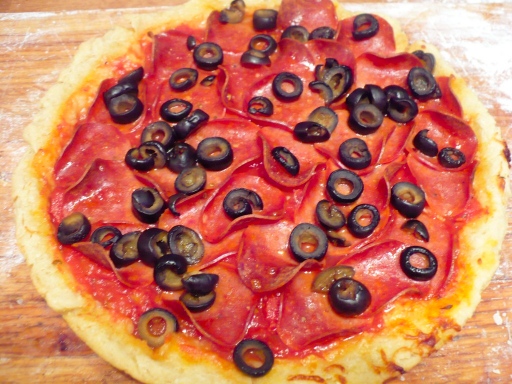I recently got an email from a reader who said that pizza was her bugaboo. She could bake gluten free bread and cookies, but pizza was the sticking point. So, we’re starting off the third section of this email course with a Q&A on baking gluten free pizza. In the next email I’ll give you the simplest gluten free pizza recipe that I think you’ll ever see. (By the way, it’s also corn free, rice free, yeast free, sugar free, and casein free!)

Q: Is delicious gluten free pizza possible?
A: Absolutely. If you don’t believe me, show up at our house any Saturday night. Chances are we’ll be serving pizza – glorious gluten free pizza. Or, if you’re ever in the San Antonio area, stop by Little Aussie’s Bakery and try one their thick-crust gluten free pizzas. Amazing!
Q: Is it hard to make gluten free pizza?
A: No, it’s not! I know it may be difficult to believe since you’ve probably never come across a good store-bought frozen crust. Pizza restaurants would like you to think that it’s hard! Many are starting to offer gluten free pizzas, and charge upwards of $25 for a 12″ pizza with two toppings (Even though they bought the crust pre-made) You can do much, much better at home in the taste and price categories. Trust me =)
Q: What goes into a gluten free pizza crust?
A: If you pare a pizza recipe down to the essential basics, you really only need flour, water, oil and salt. Yeast, sugar and spices, while nice, are really just decoration. If you can eat them, that’s wonderful. But, you don’t have to give up pizza just because you can’t have yeast and sugar. Likewise, xanthan gum and guar gum are not essential. I like to use them, but I make good pizza without them too.
Q: Do you have any guidelines for ingredient substitutions in recipes for those of us with multiple food-intolerances.
A: I’m so glad you asked, because I do! In this 3rd part of the series we’ll take a closer look at the ingredient ratios behind the recipes. Ratios provide a new way of looking at a recipe and are really helpful when you’re trying to understand a recipe and make substitutions.
Depending on the flour mix that you use, the flour to water ratio for pizza will generally be somewhere between 3 parts flour: 2 parts water (e.g 12 oz. flour: 8 oz. water) or equal parts flour and water (e.g. 12 oz. flour and 12 oz. water). The amount of xanthan or guar gum, oil and salt will all depend on how much flour you use and personal preference.
Here’s an example of how that works in real life:
I have a 12″ pizza stone (it’s all that will fit in our tiny, tiny oven), so we always make two 12″ pizzas. By trial and error I’ve found that 12 ounces of flour will make the right amount of dough, so I start by measuring 12 oz. of flour into a mixing bowl.
Next I add the ingredients that are strictly personal preference: salt (2 tsp), oil (2 Tbsp), and xanthan gum (1 Tbsp). Those amounts are not set in stone – they’re just what I like.
Now, I’m ready for the most crucial step – adding the water. If I’m using a flour mix that I’m not familiar with, or if I’ve left out or changed an ingredient (like xanthan or guar gum) that affects the amount of water that will be absorbed, then I ONLY ADD HALF THE WATER. That’s right. I start with just half because I”m not sure of what the flour to water ratio will be. So, in this example I would add 6 oz of water.
After adding half the water I mix up the dough and see what it looks like. If it’s dry and crumbly, then I ADD A LITTLE BIT MORE WATER . I add water one ounce at a time, mixing the dough after each addition, until the dough is the proper consistency. And then, if I’m really on top of things I make a note of how much water I added and jot down the flour:water ratio for making pizza with that flour.
So, to sum it up, start with a flour mix that meets your dietary needs, then add water, salt, and oil and you’ll have a great pizza. If you want, you can also add a binding agent (like xanthan gum or guar gum) and a leavening agent (like yeast, baking powder, or baking soda).
Q: That’s all well and good, but what should gluten free pizza dough feel/look like?
A: That’s a good question, because often gluten free doughs do not look like their wheat equivalents. In this case, the consistency of the dough will depend on what type of pizza you’re making. If you’re going for a thin/regular crust, then the dough should be smooth, pliable and kneadable. It may be a bit tacky, but it should be easy to pat or roll out.
The consistency of a Chicago-style thick crust pizza is very wet and sticky. It’s still rollable, but you have to take extra precautions or you’ll end up in tears and with dough all over everything. (No need to ask….anytime I make a statement like that, it IS because I’ve done it!)